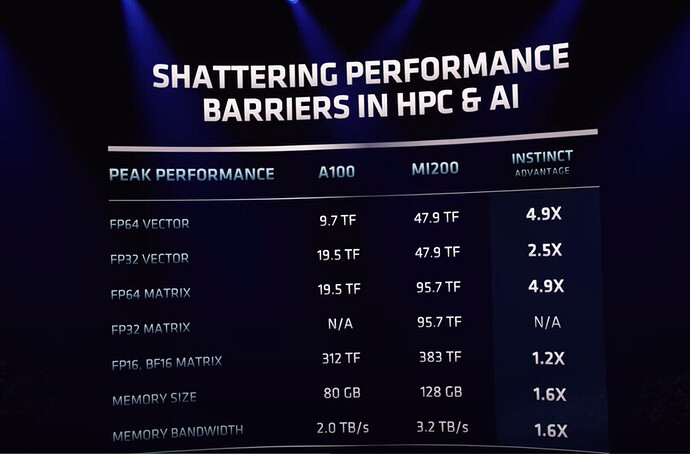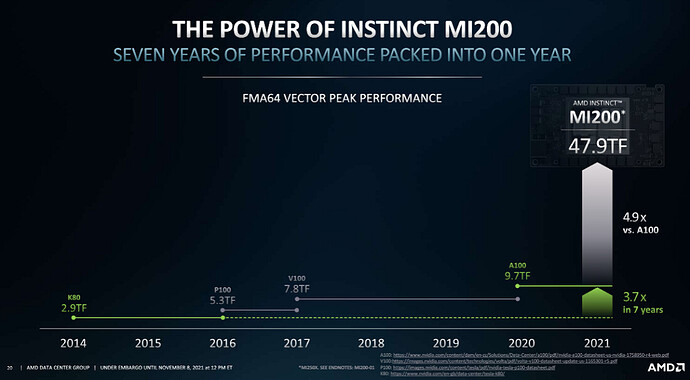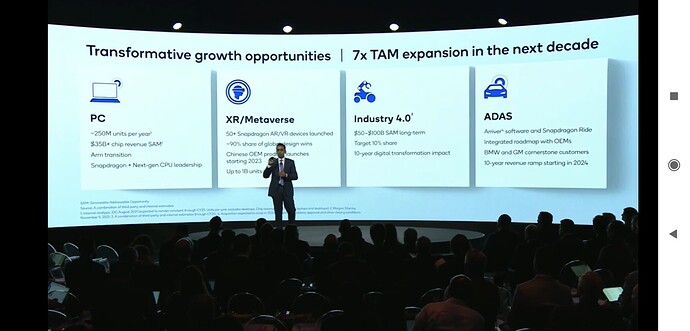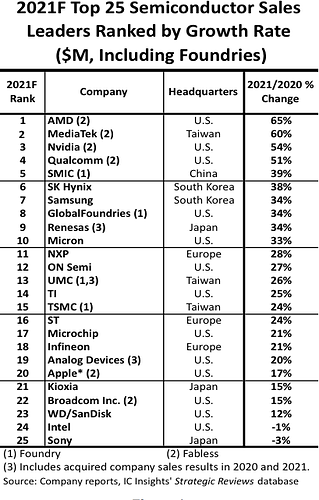Sasken Technology is in to semiconductor technology
Can we not populate this thread with non CPU/GPU questions? I am going to flag non CPU/GPU questions from here on.
Please PM for non CPU/GPU queries
Datacenter GPU competition is here.
It is official. CDNA arch has now really landed and dealt a blow to current nvidia A100. This is datacenter folks.
The following image to me is like AMD smacking Intel early 2021/late 2020 (scroll up to read live coverage of what happened) The following picture is eerily similar to when intel was sleeping for years. Except in this case, we know this is NVDA and they definitely will give an answer.
MI200 is world’s first multi chip GPU. Gear up for NVDA response with hopper.
Hopper is NVDA’s first shot at multi chip GPU.
Apart from that, Genoa 96 core (2022 production launch) and Bergamo 128 Core was also announced. Message is - Intel is not back with Alder Lake.
- We do not see Intel anywhere near AMD for next 2 years in datacenter.
- Even intel CEO has been pushing leadership goal. Currently at 2025.
Intel aims to regain chip manufacturing leadership by 2025 | VentureBeat - Dr Hsu though said sometime back that from 2022 we can expect competition for perf crown with intel. My take - “May be in consumer. But nowhere in datacenter.”
- Intel is looking at 64 count Emerald rapids only in 2023. Nowhere near 96 core Genoa coming next year and then 128 post that (dates not known)
My take - AMD is going to take more server share.
Another news.
If you want to know how and why AMD motors have been chosen for so many of the pre-exascale and exascale HPC and AI systems, despite the dominance of Intel in CPUs and the dominance of Nvidia in GPUs, you need look no further for an answer than the new “Aldebaran” Instinct MI200 GPU accelerator from AMD and its Infinity Fabric 3.0 coherent interconnect that is being also added to selected Epyc CPUs.
Good information on CPU/GPU tech indeed. My biggest regret is not buying Nvidia when it was languishing in 40s though I was well aware about their GPU capabilities and how indispensable it was for ML training. In fact I was using their GPUs to train ML model. It was bad miss indeed:(
I felt buying AMD just last year was not a bad idea either. People thought AMD come back is over after they survived. But from what we know last year itself, when I started this thread, AMD is going to give tough competition to both intel and nvda. And we were looking secular growth in CPU GPU space.
I had mentioned in this post below that both AMD and NVDA look like a good bet. “I personally feel it would be a crime now to not notice the duopoly of AMD & NVDA at play here in GPUs.”
Disclosure: I have AMD shares from the time I got them as RSUs when working for them
But while it is not uncommon for hardware companies to demonstrate their advantages, detailed performance numbers versus competition are rarely published on official websites. When they do it, it usually means one thing: very high confidence in its products.
AMD clawing market share
Out of the 70 new clusters in the fall 2021 list, Intel added 42 clusters versus AMD’s 28, with no other CPU vendors present in the new supercomputers, according to a CRN analysis. But despite adding more clusters, Intel’s share of top 500 supercomputers declined to 408, down from the 431 clusters it had in the summer 2021 list and down even further from the 459 it powered a year ago.
AMD’s momentum in the HPC space was represented in other ways, with the chipmaker’s EPYC CPUs now powering four of the top 10 supercomputers and eight of the top 20. Intel, on the other hand, powers only two of the top 10 supercomputers and five of the top 20.
NVDA on top in datacenter GPU/accelerator
As for accelerators and co-processors, Nvidia saw its share of GPUs in the world’s fastest supercomputers jump to 143 in the fall 2021 list. That represents somewhat of a bounce back for Nvidia, whose share dipped to 138 in the summer 2021 list after reaching 141 a year ago. The company’s GPUs are now represented in seven of the top 10 clusters and 14 of the top 20.
AMD Currently nowhere in accelerator but recent MI250 series to get GPU/accelerator share too
AMD, on the other hand, continued to only have one system on the list using its Instinct GPUs, the same one that has appeared in several previous lists. That is expected to change when new clusters go online using the chipmaker’s new Instinct MI250 GPUs, which includes the U.S. Department of Energy’s Frontier exascale supercomputer.
It helps to have both CPU and GPU in datacenter ecosystem. Why else would nvidia work so hard to get a CPU of their own.
Dominic Daninger, vice president of Nor-Tech, a Burnsville, Minn.-based HPC system integrator, told CRN that while his customers remain interested in Intel, there has been increasing interest in AMD.
“It’s that whole price-price performance curve—how much performance you’re getting for a buck—and AMD is a pretty good competitor there,” he said.
Intel/NVDA cannot do the following right now at the top performance bracket. It helps to have both CPU and GPU.
In a press conference, Su said Frontier is “the first fully optimized CPU and GPU design optimized for artificial intelligence and supercomputing.” AMD’s CEO said the company will also supply a custom version of its Infinity Fabric interconnect, which will provide a “first of its kind” high-bandwidth, low-latency connection between the central processor and the GPUs in a one-to-four ratio design per node.
I missed this one. We have to wait on this one. Since intel has been promising a lot lately but not much to show for.
Intel has stated that the Aurora supercomputer will use Xeon CPUs and the company’s new “Xe Compute Architecture,” which will address new workloads, particularly around artificial intelligence and data analytics.
Came across this interesting piece in WSJ writing all global progress and wealth and prosperity has come due to semiconductors and chips -
Two global semi conductor companies which have significant operations already in India and also planning expansion of the existing setup are LAM research and Applied materials.
Both these companies are big players in Semi conductor equipment segment and listed entities from USA.
Hello everyone,
This is my first post in VP forum though I’ve been regularly following it for more than 4 years.
When it comes to semiconductors everyone talks about Intel, AMD, Nvidia and even applied materials. However there’s another giant which just surpassed Intel in market cap. It is the maker of iconic product Snapdragon, Qualcomm Inc.
Qualcomm has been underperforming their peers in stock market for many years due to constant litigation. Now the company has come out of all those legal issues. Also reduced their dependency on Apple Inc. The share price is at an all-time high with forward PE of just 16xEPS. AMD and Nvidia are 40x and 80x in terms of forward PE.
Qcom market share
- Smartphones SoC leader, only 5g modem supplier to iPhones.
- AR/XR headsets 90% market share - metaverse is all about it.
- Auto and IOT market share is increasing
Investors presentation this week:
Disclosure:
Employee, and heavily invested in it through RSU and ESPP.
Hi Would like to know if anybody has view on how much semiconductor is being used for Cloud Computing CPU/GPUs out of all being used across the industry and how they are able to sustain the growth rate in this semiconductor shortage.
Some news about semiconductor shipments
The semiconductor market is forecast to increase 23% this year, fueled by changing habits caused by the Covid-19 pandemic and the subsequent economic rebound from it in 2021. A strong 20% increase in semiconductor unit shipments coupled with a 3% increase in the total semiconductor average selling price (ASP) is driving this growth. An increase of 23% would be the largest gain in the global semiconductor market since 2010 when semiconductor sales soared 34% following the financial meltdown and global recession in 2008 and 2009.
Do pay attention to the growth rate
I did not know where to place qualcomm in the CPU/GPU story. Hence I never mentioned it. There are just too many components in SOC and it makes for a very difficult analysis w.r.t competition. Atleast for me. Can you write on competitor landscape for qaulcomm while giving an overview of how to look at/analyze SoC companies and compare the same.
Again, I feel bringing in qualcom dilutes the discussion here a bit but I think this is a candidate that can be taken up along with nvda/amd/intel. Hence more details will be great.
As smartphones SoC, Qcom provides integrated and discreet application and modem processors. Making modem is a complex process and Qcom has a huge patent library for 5g that even if someone else makes one they have to pay royalty to Qcom. Intel tried to make one and gave up. Apple acquired the Intel’s modem team and continuing the modem development. Apple’s 4g iPhones had 2 variants one from Qcom and another from Intel. Intel variant was quite inferior in all aspects. 5g has 2 technologies - 1. Sub-6 and 2. millimetre wave (Qcom calls this as the real 5g)
Wrt to smartphones SoC, Qcom competitors are
- Mediatek - integrated application and modem chip. Have sub-6 and only recently introduced mmWave. Products are yet to come with it’s mmWave.
- Samsung with their Exynos series - application and modem chip. Only sub-6. Samsung uses Qcom’s SoCs in their premium phones in premium markets. Their SoCs are sub-par.
- Google with their new Tensor SoC - with Samsung’s modem. Until this year Google’s pixel were using Qcom SoC exclusively.
- Huawei Kirin - due to USA sanctions they can no longer make their own SoC. They are using Qcom and mediatek SoCs.
- Apple with A series - only application processor. Modem is from Qcom so far. Developing their own 5g modem with the team they acquired from Intel.
- Xiaomi tried their own SoC for application processor, it didn’t work out.
- Oppo just announced they’re making one flagship application SoC. Need to watch how they do when we already see most companies dig at it and their failure.
Major customers of Qcom’s smartphones SoC are
- Xiaomi - new no 1 in Europe
- Oppo
- Vivo
- Huawei
- Samsung
- OnePlus
- Apple
- Realme, iQOO, LG, the list is endless.
And then Qcom has acquired Nuvia Inc, a start-up by apple’s m1 chip designers, with their expertise Qcom is planning to take apple head on in ARM based laptop and PC cpu market. Microsoft has partnered with Qcom to develop always connected, ultra low power consuming surface pro devices. Products could be rolled out in the next 9 to 12 months.
Disclosure:
Employee, and heavily invested in it through RSU and ESPP.
All the above information is publicly available.
I think this calls for a thread on 5G theme and the players in it
Tejas network can be discussed
Not this thread. Some has to take the lead and start a new thread.
Very interesting interview with Jensen on Omniverse and competition with AMD in HPC.






